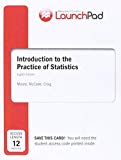
(a)
To graph: A diagram with the use of confidence interval applet.
(a)
Explanation of Solution
Calculation: To construct confidence inetrvals, use confidence interval applet. The following steps are provided below:
Step 1: Go to the “Confidence interval applets” in the website. The screenshot is
shown below:
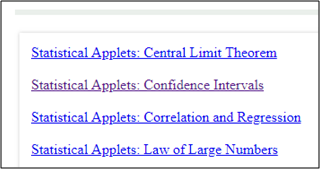
Step 2: Specify confidence interval as “80” and specify the
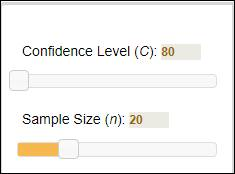
Step 3: Click on the “Sample 25” to generate the sample. The screenshot is shown below:
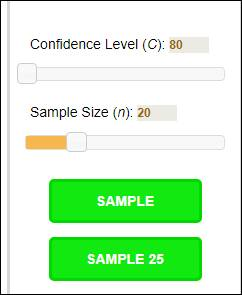
Graph: The obtained output is shown below:
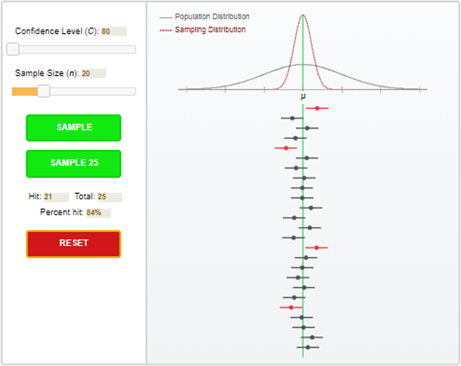
From the above srceenshot, intervals that contain the true
Interpretation: From the above output, out of a total 25, 21 intervals contain the true mean and the proportion of the interval that contains true mean is 84%.
(b)
To find: The confidence interval with 50 SRSs.
(b)
Answer to Problem 5UYK
Solution: The confidence interval with 50 SRSs is shown below:
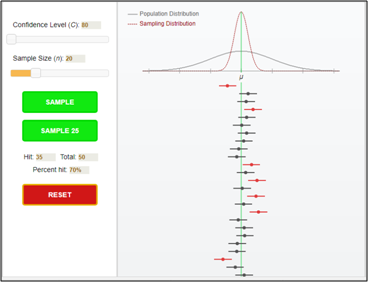
Explanation of Solution
Calculation: To construct confidence intervals, use confidence interval applet. The following steps are provided below:
Step 1: Go to the “Confidence interval applets” in the website. The screenshot is shown below:

Step 2: Specify confidence interval as “80” and specify the sample size as “20.” The screenshot is shown below:
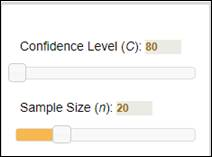
Step 3: Click twice on the “Sample 25” to generate the sample. The screenshot is shown below:
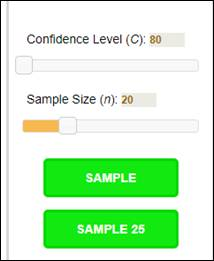
The obtained output is shown below:
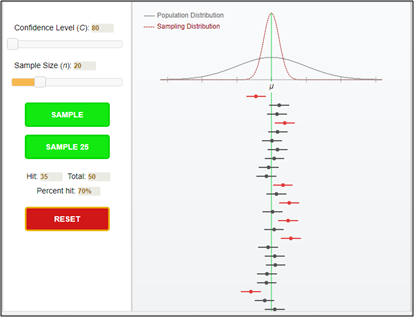
From the above sceenshort, intervals that contain the true mean
Interpretation: The above figure indicates the hit 35, total 50, and percent hit 70%. Thirty-five out of 50 intervals contain the true mean and the proportion of the interval that contains the true mean is 70%.
To find: The confidence interval with 100 SRSs.
Answer to Problem 5UYK
Solution: The confidence interval with 100 SRSs is shown below:
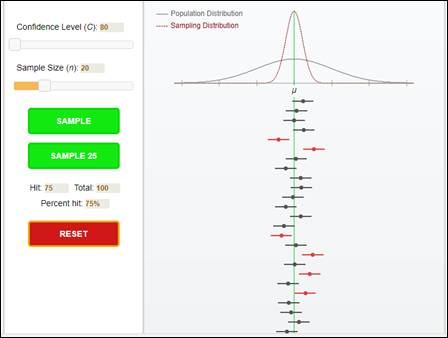
Explanation of Solution
Calculation: To construct confidence inetrvals, use confidence interval applet. The following steps are provided below:
Step 1: Go to the “Confidence interval applets” in the website. The screenshot is shown below:
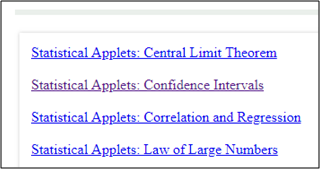
Step 2: Specify confidence interval as “80” and specify the sample size as “20.” The screenshot is shown below:

Step 3: Click four times on the “Sample 25” to generate the sample. The screenshot is shown below:

The obtained output is shown below:
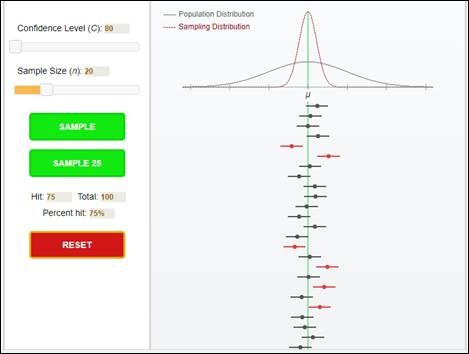
From the above sceenshort, intervals that contain the true mean
Interpretation: The above figure indicates the hit 75, total 100, and percent hit 75%. Seventy-five out of 100 intervals contain the true mean and the proportion of the interval that contains the true mean is 75%.
To find: The confidence interval with 200 SRSs.
Answer to Problem 5UYK
Solution: The confidence interval with 200 SRSs is shown below:
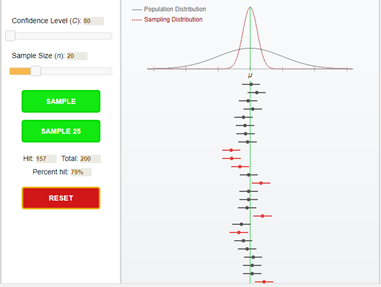
Explanation of Solution
Calculation: To construct confidence inetrvals, use confidence interval applet. The following steps are provided below:
Step 1: Go to the “Confidence interval applets” in the website. The screenshot is shown below:
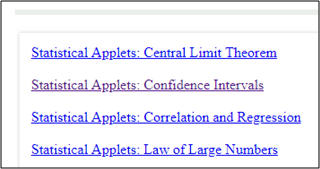
Step 2: Specify confidence interval as “80” and specify the sample size as “20.” The screenshot is shown below:

Step 3: Click eight times on the “Sample 25” to generate the sample. The screenshot is shown below:

The obtained output is shown below:
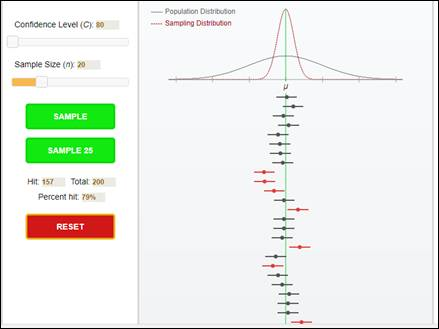
From the above sceenshort, intervals that contain the true mean
Interpretation: The above figure indicates the hit 157, total 200, and percent hit 79%. One hundred and fifty-seven out of 200 intervals contain the true mean and the proportion of the interval that contains the true mean is 79%.
To find: The confidence interval with 300 SRSs.
Answer to Problem 5UYK
Solution: The confidence interval with 300 SRSs is shown below:
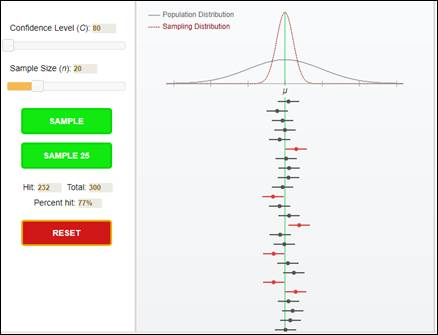
Explanation of Solution
Calculation: To construct confidence inetrvals, use confidence interval applet. The following steps are provided below:
Step 1: Go to the “Confidence interval applets” in the website. The screenshot is shown below:

Step 2: Specify confidence interval as “80” and specify the sample size as “20.” The screenshot is shown below:

Step 3: Click 12 times on the “Sample 25” to generate the sample. The screenshot is shown below:

The obtained output is shown below:
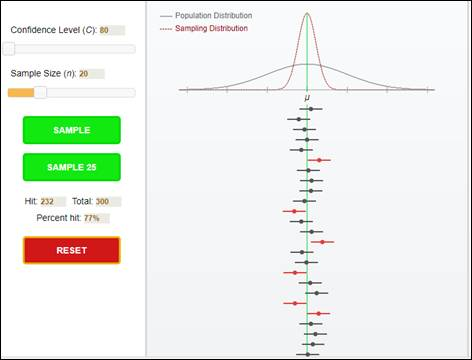
From the above sceenshort, intervals that contain the true mean
Interpretation: The above figure indicates the hit 232, total 300, and percent hit 77%. Two hundred and thirty-two out of 300 intervals contain the true mean and the proportion of the interval that contains the true mean is 77%.
To find: The confidence interval with 400 SRSs.
Answer to Problem 5UYK
Solution: The confidence interval with 400 SRSs is shown below:
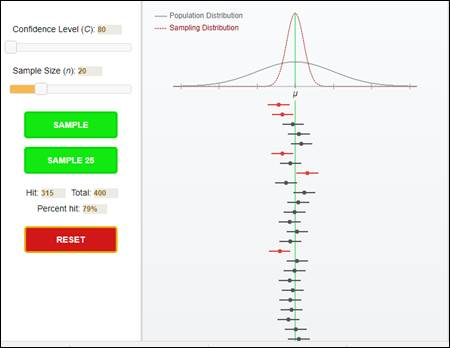
Explanation of Solution
Calculation: To construct confidence inetrvals, use confidence interval applet. The following steps are provided below:
Step 1: Go to the “Confidence interval applets” in the website. The screenshot is shown below:
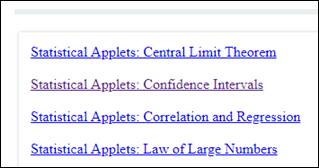
Step 2: Specify confidence interval as “80” and specify the sample size as “20.” The screenshot is shown below:

Step 3: Click 16 times on the “Sample 25” to generate the sample. The screenshot is shown below:

The obtained output is shown below:
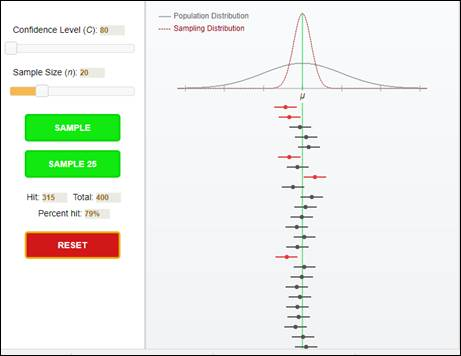
From the above sceenshort, intervals that contain the true mean
Interpretation: The above figure indicates the hit 315, total 400, and percent hit 79%. Three hundred and fifteen out of 400 intervals contain the true mean and the proportion of the interval that contains the true mean is 79%.
To find: The confidence interval with 500 SRSs.
Answer to Problem 5UYK
Solution: The confidence interval with 500 SRSs is shown below:
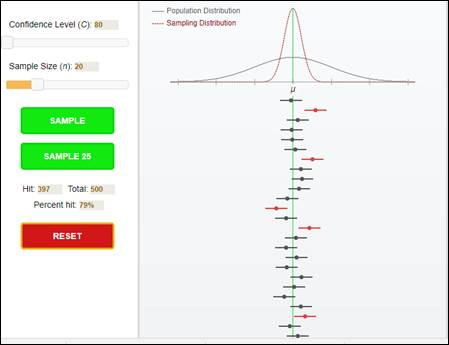
Explanation of Solution
Calculation: To construct confidence inetrvals, use confidence interval applet. The following steps are provided below:
Step 1: Go to the “Confidence interval applets” in the website. The screenshot is shown below:

Step 2: Specify confidence interval as “80” and specify the sample size as “20.” The screenshot is shown below:

Step 3: Click 20 on the “Sample 25” to generate the sample. The screenshot is shown below:

The obtained output is shown below:
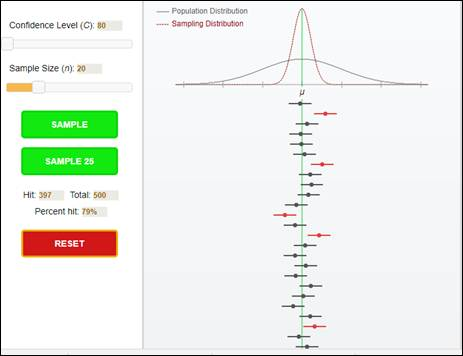
From the above sceenshort, intervals that contain the true mean
Interpretation: The above figure indicates the hit 397, total 500, and percent hit 79%. Three hundred and ninety-seven out of 500 intervals contain the true mean and the proportion of the interval that contains the true mean is 79%. From the pattern in the above seven cases, the proportion hit approaches near by 80% as the number of sample increases. Thus, one should expect that the percent capture to get closer to the confidence interval level is 80% as the number of samples increases.
Want to see more full solutions like this?
Chapter 6 Solutions
LaunchPad for Moore's Introduction to the Practice of Statistics (12 month access)
- WHAT IS THE SOLUTION?arrow_forwardThe following ordered data list shows the data speeds for cell phones used by a telephone company at an airport: A. Calculate the Measures of Central Tendency from the ungrouped data list. B. Group the data in an appropriate frequency table. C. Calculate the Measures of Central Tendency using the table in point B. 0.8 1.4 1.8 1.9 3.2 3.6 4.5 4.5 4.6 6.2 6.5 7.7 7.9 9.9 10.2 10.3 10.9 11.1 11.1 11.6 11.8 12.0 13.1 13.5 13.7 14.1 14.2 14.7 15.0 15.1 15.5 15.8 16.0 17.5 18.2 20.2 21.1 21.5 22.2 22.4 23.1 24.5 25.7 28.5 34.6 38.5 43.0 55.6 71.3 77.8arrow_forwardII Consider the following data matrix X: X1 X2 0.5 0.4 0.2 0.5 0.5 0.5 10.3 10 10.1 10.4 10.1 10.5 What will the resulting clusters be when using the k-Means method with k = 2. In your own words, explain why this result is indeed expected, i.e. why this clustering minimises the ESS map.arrow_forward
- why the answer is 3 and 10?arrow_forwardPS 9 Two films are shown on screen A and screen B at a cinema each evening. The numbers of people viewing the films on 12 consecutive evenings are shown in the back-to-back stem-and-leaf diagram. Screen A (12) Screen B (12) 8 037 34 7 6 4 0 534 74 1645678 92 71689 Key: 116|4 represents 61 viewers for A and 64 viewers for B A second stem-and-leaf diagram (with rows of the same width as the previous diagram) is drawn showing the total number of people viewing films at the cinema on each of these 12 evenings. Find the least and greatest possible number of rows that this second diagram could have. TIP On the evening when 30 people viewed films on screen A, there could have been as few as 37 or as many as 79 people viewing films on screen B.arrow_forwardQ.2.4 There are twelve (12) teams participating in a pub quiz. What is the probability of correctly predicting the top three teams at the end of the competition, in the correct order? Give your final answer as a fraction in its simplest form.arrow_forward
- The table below indicates the number of years of experience of a sample of employees who work on a particular production line and the corresponding number of units of a good that each employee produced last month. Years of Experience (x) Number of Goods (y) 11 63 5 57 1 48 4 54 5 45 3 51 Q.1.1 By completing the table below and then applying the relevant formulae, determine the line of best fit for this bivariate data set. Do NOT change the units for the variables. X y X2 xy Ex= Ey= EX2 EXY= Q.1.2 Estimate the number of units of the good that would have been produced last month by an employee with 8 years of experience. Q.1.3 Using your calculator, determine the coefficient of correlation for the data set. Interpret your answer. Q.1.4 Compute the coefficient of determination for the data set. Interpret your answer.arrow_forwardCan you answer this question for mearrow_forwardTechniques QUAT6221 2025 PT B... TM Tabudi Maphoru Activities Assessments Class Progress lIE Library • Help v The table below shows the prices (R) and quantities (kg) of rice, meat and potatoes items bought during 2013 and 2014: 2013 2014 P1Qo PoQo Q1Po P1Q1 Price Ро Quantity Qo Price P1 Quantity Q1 Rice 7 80 6 70 480 560 490 420 Meat 30 50 35 60 1 750 1 500 1 800 2 100 Potatoes 3 100 3 100 300 300 300 300 TOTAL 40 230 44 230 2 530 2 360 2 590 2 820 Instructions: 1 Corall dawn to tha bottom of thir ceraan urina se se tha haca nariad in archerca antarand cubmit Q Search ENG US 口X 2025/05arrow_forward
- The table below indicates the number of years of experience of a sample of employees who work on a particular production line and the corresponding number of units of a good that each employee produced last month. Years of Experience (x) Number of Goods (y) 11 63 5 57 1 48 4 54 45 3 51 Q.1.1 By completing the table below and then applying the relevant formulae, determine the line of best fit for this bivariate data set. Do NOT change the units for the variables. X y X2 xy Ex= Ey= EX2 EXY= Q.1.2 Estimate the number of units of the good that would have been produced last month by an employee with 8 years of experience. Q.1.3 Using your calculator, determine the coefficient of correlation for the data set. Interpret your answer. Q.1.4 Compute the coefficient of determination for the data set. Interpret your answer.arrow_forwardQ.3.2 A sample of consumers was asked to name their favourite fruit. The results regarding the popularity of the different fruits are given in the following table. Type of Fruit Number of Consumers Banana 25 Apple 20 Orange 5 TOTAL 50 Draw a bar chart to graphically illustrate the results given in the table.arrow_forwardQ.2.3 The probability that a randomly selected employee of Company Z is female is 0.75. The probability that an employee of the same company works in the Production department, given that the employee is female, is 0.25. What is the probability that a randomly selected employee of the company will be female and will work in the Production department? Q.2.4 There are twelve (12) teams participating in a pub quiz. What is the probability of correctly predicting the top three teams at the end of the competition, in the correct order? Give your final answer as a fraction in its simplest form.arrow_forward
 MATLAB: An Introduction with ApplicationsStatisticsISBN:9781119256830Author:Amos GilatPublisher:John Wiley & Sons Inc
MATLAB: An Introduction with ApplicationsStatisticsISBN:9781119256830Author:Amos GilatPublisher:John Wiley & Sons Inc Probability and Statistics for Engineering and th...StatisticsISBN:9781305251809Author:Jay L. DevorePublisher:Cengage Learning
Probability and Statistics for Engineering and th...StatisticsISBN:9781305251809Author:Jay L. DevorePublisher:Cengage Learning Statistics for The Behavioral Sciences (MindTap C...StatisticsISBN:9781305504912Author:Frederick J Gravetter, Larry B. WallnauPublisher:Cengage Learning
Statistics for The Behavioral Sciences (MindTap C...StatisticsISBN:9781305504912Author:Frederick J Gravetter, Larry B. WallnauPublisher:Cengage Learning Elementary Statistics: Picturing the World (7th E...StatisticsISBN:9780134683416Author:Ron Larson, Betsy FarberPublisher:PEARSON
Elementary Statistics: Picturing the World (7th E...StatisticsISBN:9780134683416Author:Ron Larson, Betsy FarberPublisher:PEARSON The Basic Practice of StatisticsStatisticsISBN:9781319042578Author:David S. Moore, William I. Notz, Michael A. FlignerPublisher:W. H. Freeman
The Basic Practice of StatisticsStatisticsISBN:9781319042578Author:David S. Moore, William I. Notz, Michael A. FlignerPublisher:W. H. Freeman Introduction to the Practice of StatisticsStatisticsISBN:9781319013387Author:David S. Moore, George P. McCabe, Bruce A. CraigPublisher:W. H. Freeman
Introduction to the Practice of StatisticsStatisticsISBN:9781319013387Author:David S. Moore, George P. McCabe, Bruce A. CraigPublisher:W. H. Freeman





